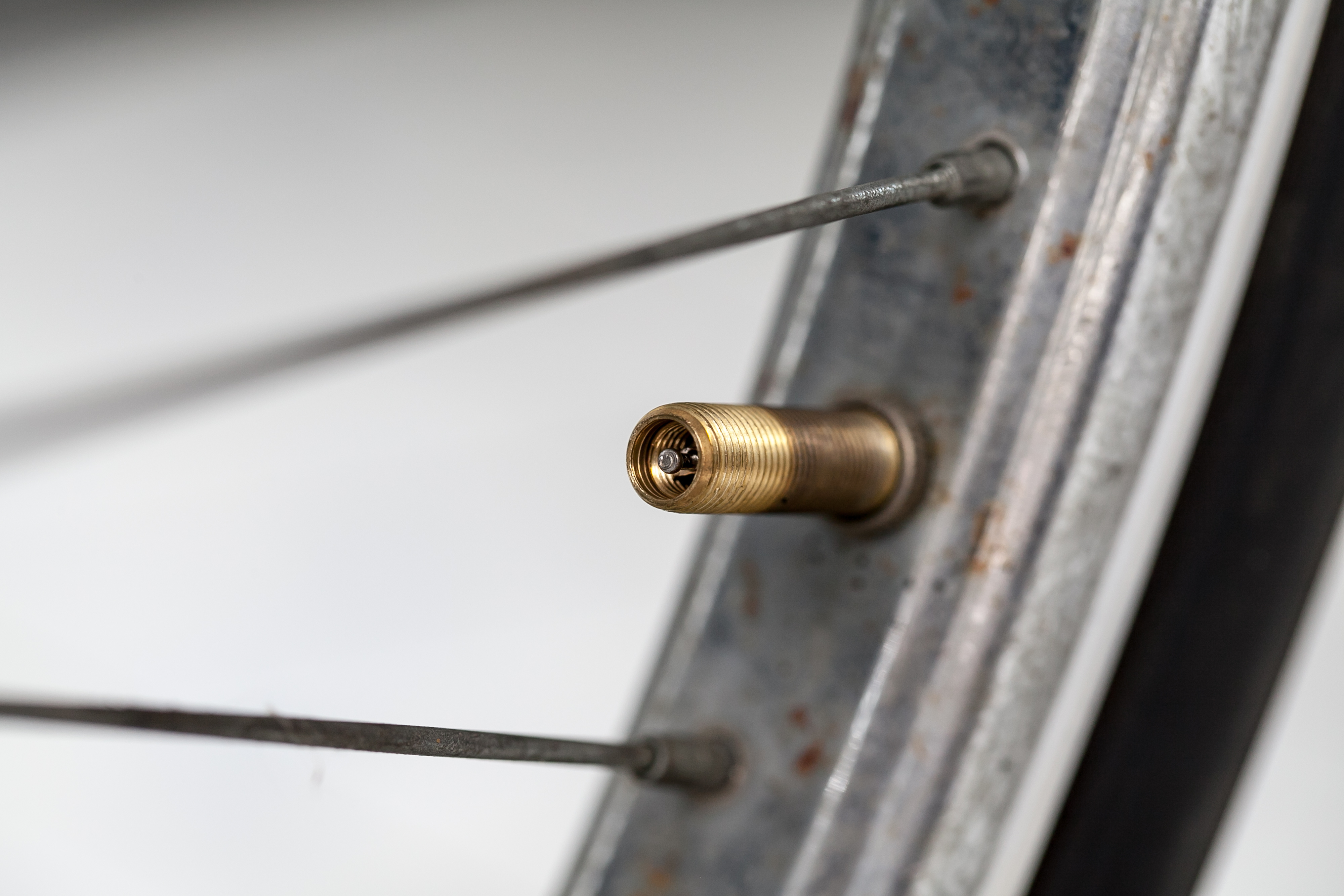Replacing a tube, changing your tires, buying a pump…these are all routine tasks for any road cyclist or mountain biker. And if you’re new to cycling, working on your rig for the first time, trying out a new brand, or switching disciplines within the sport, you’re bound to be introduced at one point or another to the different types of bike tire valves.
Today’s article will teach you about the differences between the three most common types of bike tire valves. They’ve evolved over the years and each have their own benefits, drawbacks, and specific purposes.
Bike Tire Valve Types
Knowing what valve(s) you’re working with will help you be prepared for repairs, maintenance, and helping out a buddy midway through a troublesome ride. You’ll be able to identify each valve and ensure you have the proper equipment to tackle the job. Let’s jump in.
Schrader Valve

Schrader valve. (Credit: todja/Adobe Stock)
The Schrader valve is the most common valve type, also known as the American valve, named after its inventor, August Schrader. It was designed in 1891 and patented in the United States in 1893.
It is a sturdy valve type found on almost all cars and motorcycles. It has a wider diameter and can hold higher air pressures than other valves, making it easy to fill up at gas stations and suitable for mountain bikes or other heavy-duty suspension systems. The Schrader valve has a spring-loaded pin that closes the valve when the pump is removed, ensuring a secure seal.
Schrader valves are common in agriculture, hospitals, firefighting, and a wide range of other industries. In cycling, apart from road bikes, the Schrader valve can be found on most kid’s bikes, cruisers, hybrids, and mountain bikes.
Presta Valve
Presta valve. (Credit: Narayan/Adobe Stock)
The Presta valve is a narrower and lighter valve type. It was invented by Frenchman Etienne Sclaverand, and was initially known as the Sclaverand valve. Today, it is also known as the French valve or a high-pressure valve.
It is commonly found on road bikes and high-performance bikes, including some mountain bikes. It is designed for high-pressure tires and can hold up to 120 PSI. The Presta valve has a threaded stem that screws into the rim, creating an airtight seal. It also has a lock nut that secures the valve stem to prevent air from leaking.
The hole on a bike tire valve is usually the weakest point on the rim. But because the Presta valve has a smaller opening, it can maintain strength in the wheel and support the razor thin tires fitted onto top-of-the-line racing bikes.
Woods (Dunlop) Valve
Woods (Dunlop) valve. (Credit: rdnzl/Adobe Stock)
The Dunlop valve was originally invented by a Scottish inventor by the name of John Boyd Dunlop in the late 1800’s. It was however quickly improved upon by a man named C.H. Woods, who made it easier to inflate and maintain than the original. This is why the Dunlop valve is now often referred to as the Woods valve.
Originally, this valve type used a tight rubber sleeve to regulate airflow. This sleeve unfortunately would break down overtime and took substantial air pressure to be forced open when pumping. Modern Woods valves use an internal ball bearing or spring-loaded rubber plug that is easily unsaddled with pumping.
Woods valves are not often seen in North America, and are more common in Europe, across Asia, and developing countries around the world. Their durable stem and easy to perform maintenance make them popular where resources are more scarce.
Bike Tire Pumps & Valve Adapters
Knowing what valves you’re dealing with or may come across is one thing, the next step is ensuring you have the right equipment to service them if and when the time comes.
Bike Tire Pumps
There are four main types of pumps that are commonly used in the sport of cycling, they are:
- Floor Pumps
- Mini Pumps
- Frame Pumps
- CO2 Inflators
Each of these have their own unique advantages and disadvantages.

Cyclist using a mini pump. (Credit: Odua Images/Adobe Stock)
Floor pumps are the most durable and one of the fastest ways to inflate your tires, but are often too large and cumbersome to carry while riding.
Mini pumps take longer to inflate your tires and can have some pressure limitations, but are small enough to carry in your jersey pocket or hydration pack.
Frame pumps attach easily to your frame and come in different sizes that offer varying inflation speeds, however some don’t like having the extra hardware hanging off their bike.
CO2 inflators are compact and extremely efficient when it comes to inflating your tires. The biggest drawback is their limited use and disposability.
Depending on the brand and model, each of these pump types can be found to accommodate both Schrader and Presta valves, the two most common bike tire valve types. Some will come equipped to serve both, while others you may need to fit with a valve extender/reducer or adapter.
Bike Tire Valve Adapters
Bike tire valve adapters are small, but essential, components that allow you to use one type of valve with another. Especially if you ride with others, they’re good to have on hand should you or your partners need help on the side of the road.
Presta to Schrader Adapter
Converts a Presta valve to a Schrader valve, allowing you to inflate a tire with a Presta valve using only a Schrader pump.
Schrader to Presta Adapter
Ideal when using a Presta pump to inflate a tire with a Schrader valve.
Presta Valve Extender
Attach a small metal or plastic tube to a Presta valve with a Presta valve extender, lengthening the valve above the rim for easy access with a pump head.
Schrader Valve Extender
When a Schrader valve is too short to reach the pump head or buried deep in the rim, you can use this extender to enhance the valve beyond the rim’s surface.
Valve Reducers
For those with a Schrader pump and a tire with a smaller Presta valve, valve reducers can convert the Schrader pump head to fit the smaller valve diameter.
Left to right: Presta, Dunlop/Woods, Schrader. (Credit: NilsZ/Adobe Stock)
Being prepared for those inevitable roadside flats starts with knowing what kind of tire you’re riding and how to service it. Having the right equipment and fittings on hand can turn a would-be-day-wrecker into a quick and simple fix!
Understanding the different bike tire valve types will help you get to know your bike better, and make you more confident going out on long rides where the ability to be self-sufficient becomes ever more important.
We hope this article has been helpful on your journey to better, stronger, pain (and headache) free cycling!